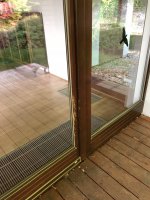threesixright
Member
- Joined
- Aug 17, 2017
- Messages
- 655
Hi All,
Soon I will need to start sanding inside doors (~ 10, and the door frames) + 10 larger outside windows/door (both sides). All together lots of work (I think).
I already have a ROTEX 125, but since most of this is vertical, I'm not sure if that the right machine to use? Or just go with and sanding ( [scared])?
I'm in doubt to add a RO 90 or maybe the RTS/DTS 400 combo is better for this? Any other/better suggestions?
Secondly:
Not sure if the color matters, but this should go from (what you see on the picture) brown to graphite black (RAL 9011).
What would be the best way to approach this?
- clean
- sanding
- primer (which color?)
- light sanding
- 1st layer
- light sanding
- 2nd layer ?
Thank you all.
Soon I will need to start sanding inside doors (~ 10, and the door frames) + 10 larger outside windows/door (both sides). All together lots of work (I think).
I already have a ROTEX 125, but since most of this is vertical, I'm not sure if that the right machine to use? Or just go with and sanding ( [scared])?
I'm in doubt to add a RO 90 or maybe the RTS/DTS 400 combo is better for this? Any other/better suggestions?
Secondly:
Not sure if the color matters, but this should go from (what you see on the picture) brown to graphite black (RAL 9011).
What would be the best way to approach this?
- clean
- sanding
- primer (which color?)
- light sanding
- 1st layer
- light sanding
- 2nd layer ?
Thank you all.

